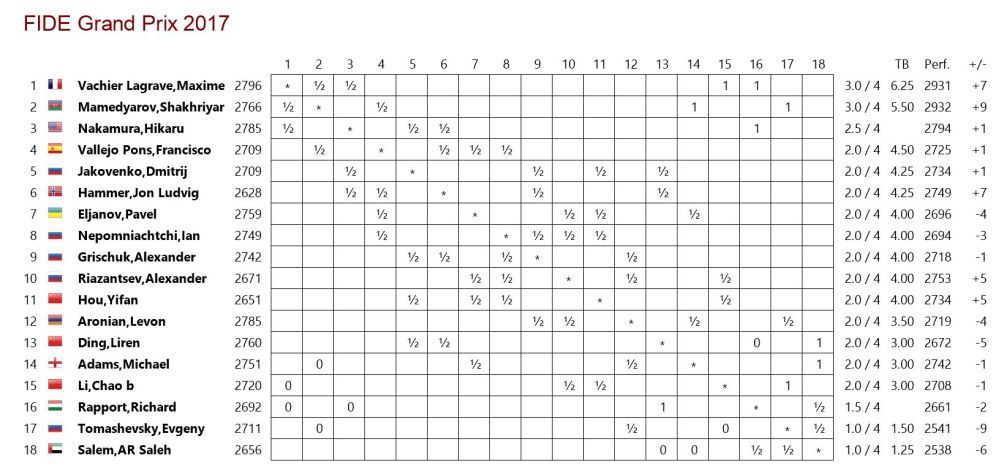Sharjah 03+04: Mamedyarov joins MVL at the top
We are nearing the half way mark at the 1st leg of the FIDE Grand Prix held in Sharjah. After four rounds we have two leaders in the form of Maxime Vachier Lagrave and Shakhriyar Mamedyarov. While this reports gives you the results and pictures, the highlight definitely is the in-depth annotations by world class trainer and author Efstratios Grivas. Check out his analysis and improve your understanding of chess.
Max Avdeev
Shakhriyar Mamedyarov of Azerbaijan overcame Michael Adams of England in Round 4 of the Sharjah Grand Prix to pull into a tie for first with Maxime Vachier-Lagrave of France. Hikaru Nakamura of the United States sits alone in third, a half point behind the leaders.
Results of Round 4
| Bo | No | Ti. | Name | Rtg | Pts. | Result | Pts. | Ti | Name | Rtg | No |
| 1 | 3 | GM | Nakamura Hikaru | 2785 | 2 | ½ - ½ | 2½ | GM | Vachier-Lagrave Maxime | 2796 | 1 |
| 2 | 4 | GM | Mamedyarov Shakhriyar | 2766 | 2 | 1 - 0 | 2 | GM | Adams Michael | 2751 | 7 |
| 3 | 2 | GM | Aronian Levon | 2785 | 1½ | ½ - ½ | 1½ | GM | Riazantsev Alexander | 2671 | 15 |
| 4 | 12 | GM | Jakovenko Dmitry | 2709 | 1½ | ½ - ½ | 1½ | GM | Ding Liren | 2760 | 5 |
| 5 | 6 | GM | Eljanov Pavel | 2759 | 1½ | ½ - ½ | 1½ | GM | Hou Yifan | 2651 | 17 |
| 6 | 8 | GM | Nepomniachtchi Ian | 2749 | 1½ | ½ - ½ | 1½ | GM | Grischuk Alexander | 2742 | 9 |
| 7 | 18 | GM | Hammer Jon Ludvig | 2628 | 1½ | ½ - ½ | 1½ | GM | Vallejo Pons Francisco | 2709 | 13 |
| 8 | 10 | GM | Li Chao B | 2720 | 1 | 1 - 0 | 1 | GM | Tomashevsky Evgeny | 2711 | 11 |
| 9 | 14 | GM | Rapport Richard | 2692 | 1 | ½ - ½ | ½ | GM | Salem A.R. Saleh | 2656 | 16 |

Mamedyarov was tied for second with Adams and Nakamura after Round 3. In Round 4, Mamedyarov had White and managed to take control of the center. Rather than resort to passive defense and be slowly strangled, Adams tried a risky strategy of sacrificing a piece to destroy White’s center. It almost worked, indeed it would have if Adams had taken advantage of a couple of imprecise moves by Mamedyarov. But Mamedyarov managed to consolidate his position and eventually put his extra piece to good use, ensnaring Adams’ king in a powerful attack.

[Site "Sharjah"]
[Date "2017.02.21"]
[Round "4"]
[White "Mamedyarov, Shakhriyar"]
[Black "Adams, Michael"]
[Result "1-0"]
[ECO "D35"]
[WhiteElo "2766"]
[BlackElo "2751"]
[Annotator "Efstratios Grivas"]
[PlyCount "85"]
[EventDate "2017.02.18"]
[EventCountry "UAE"]
Structure' in the 'Queen's Gambit Declined' is a quite old one weapon, rich n
strategical and tactical ideas.} 5. Bg5 c6 6. e3 h6 ({Certain GMs accepts to
play with a ruined pawn structure after} 6... Bf5 {, for example} 7. Qf3 Bg6 8.
Bxf6 Qxf6 9. Qxf6 gxf6 {, as in Carlsen,M-Kramnik,V Stavanger 2016, based on
the bishop pair and easy development. But this is not the cup of tea of M.
Adams. Of course Black has some other continuations as well at his disposal
here.}) 7. Bh4 Be7 8. Bd3 Nbd7 {(D) [#] Here we are on crossroads.} 9. Nge2 ({
Most common seems to be} 9. Qc2 Nh5 10. Bxe7 Qxe7 11. O-O-O (11. Nge2 Nb6 12.
O-O O-O 13. Rae1 Be6 14. Nc1 Rad8 15. Nb3 Rfe8 16. Nc5 Bc8 17. b4 $13 {Navara,
D-Adams,M Biel 2015}) 11... Nb6 12. h3 Be6 13. Nf3 Nf6 14. Kb1 O-O-O 15. Nd2
Kb8 16. Nb3 Rhe8 17. f3 Nfd7 18. Rhe1 $13 {Tomashevsky,E-Adams,M Wijk aan Zee
2016.}) ({Also playable is} 9. f3 O-O 10. Qc2 b5 11. Nge2 Nb6 12. a3 a5 13. O-O
Bd7 14. Nc1 Nc4 15. Re1 Be6 $13 {So,W-Adams,M Shamkir 2015. As we can
understand, M.Adams has a vast experience in this line...}) 9... Nh5 {The
usual manoeuvre in similar positions, adopted firstly in top-level by J.R.
Capablanca. Black easies his position by a well timed exchange of the
darksquared bishops.} 10. Bxe7 Qxe7 11. Qd2 (11. O-O O-O 12. Qd2 Re8 13. Rae1
Nb6 14. Nc1 Qg5 15. f3 Bf5 16. Bxf5 Qxf5 17. e4 Nc4 18. Qe2 Qg5 $13 {Giri,
A-Fressinet,L Montpellier 2015, is not offering much to White, so he tries a
similar concept but with a different move order which might be tricky.}) 11...
Nb6 12. f3 {(D) [#] The main White's idea in this pawn structure. By f3 and a
well-timed e4, White wants to dominate the centre.} Bd7 ({Technically a
novelty.} 12... Be6 13. O-O O-O 14. b3 Rac8 15. Rac1 {was played in Hillarp
Persson,T-Merriman,J London 2015.}) 13. O-O O-O 14. g4 $5 ({Another common
idea in the 'Queen's Gambit Declined' and in the 'Nimzoindian Defence'. White
is in no hurry for e4, preparing it with Ng3 and Rae1. Possible is} 14. e4 dxe4
15. fxe4 c5 $1 16. d5 Rae8 $13 {.}) 14... Nf6 15. Ng3 Ne8 ({An interesting,
but not innovating plan! Black wants to place his knight on d6, but I think
that good is} 15... c5 {and then moving the rooks to the central squares d8
and e8.}) 16. Rae1 Nd6 {(D) [#]} 17. e4 $5 ({It is now or never! Although
White is sacrificing a pawn, he gets a nice initiative. The main alternative
was} 17. b3 f5 $1 18. h3 Rae8 $13 {.}) 17... dxe4 18. fxe4 $1 {(D) [#]} (18.
Ncxe4 Nxe4 19. Nxe4 Be6 {is no problem for Black.}) 18... Ndc4 ({If Black
grabbed the pawn directly with} 18... Bxg4 {, White seems to get fine
compensation by} 19. e5 $1 Nb5 (19... Ndc4 $5 20. Qg2 $44) 20. Nxb5 cxb5 21.
Bf5 $1 Bxf5 22. Nxf5 Qg5+ 23. Qxg5 hxg5 24. Rc1 $1 $14 {.}) 19. Qc1 Bxg4 {
Black had no option; otherwise White would have succeeded playing e4 for free!}
20. b3 {(D) [#]} Rad8 $6 ({Black decided to sacrifice a piece for some pawns,
as he didn't like his position after} 20... Na3 21. e5 Be6 (21... Qb4 $2 22.
Qf4 Be6 23. Re3 $1 $16) 22. Nce4 $44 {.}) 21. Nf5 $1 Bxf5 22. exf5 Qf6 {(D) [#]
} ({Black preferred to preserve queens on the board, pondering on the weak
white king. He could also opt for} 22... Qa3 23. Bxc4 Qxc1 24. Rxc1 Nxc4 25.
bxc4 Rxd4 26. c5 $14 {, where his healthy pawn structure can be helpful to
hold this endgame.}) 23. Bxc4 Nxc4 24. bxc4 Qxd4+ 25. Kh1 {(D) [#] White got a
piece for three pawns (the c4 will fall) and he still holds the initiative;
his position is preferable.} Rfe8 $5 ({Accurate, as the 'greedy'} 25... Qxc4 $6
{would allow White a nice initiative after} 26. Rg1 $1 Kh7 (26... Qd4 $2 27.
Re4 Qd2 28. Qa1 $1 $18) 27. f6 g6 28. Re7 $16 {.}) 26. f6 $1 {(D) [#] A good
lesson to learn from. As the extra piece might not prove enough, White creates
weaknesses on the opponent king, hoping to benefit from his extra piece in a
potential attack.} Rxe1 27. Qxe1 Qxc4 (27... g6 {allows} 28. Qe7 {, planning
Ne4 and/or c5, Nd6.}) 28. fxg7 {Black's king is weakened but on the other hand
a couple of pawns are exchanged as well, which generally favours Black in his
way to the draw.} Rd6 $1 {(D) [#]} 29. Rg1 $2 ({Quite similar with the game
but forceful was} 29. Qe8+ $1 Kxg7 30. Rf3 Rf6 31. Qe5 Qe6 32. Rg3+ Kh7 33. Qb8
Rg6 34. Rxg6 Kxg6 35. Qxa7 {.}) 29... Rg6 30. Qe5 {(D) [#]} Qe6 $2 ({Black
didn't get his chances here. With} 30... Qd3 $1 {he would draw; in most of the
variations with perpetual check on the squares f3 and f1.}) 31. Qb8+ Kxg7 32.
Qxa7 Qc4 33. Qe3 {White won a pawn and the duo queen + knight will damage the
black king. I do not think that Black can survive from here on.} b5 34. a3 c5 {
(D) [#] Black must try to create counterplay with a passed queenside pawn, but
he never even comes close.} 35. Ne4 $6 {(D) [#]} ({It looks like better was}
35. Qe5+ $1 Kh7 36. Re1 Qd3 37. Qe3 $16 {.}) 35... f5 $2 ({An awful move!
Black had to opt for} 35... b4 $1 36. axb4 cxb4 37. Rxg6+ fxg6 (37... Kxg6 $2
38. Qg3+ $18) 38. Nd2 Qd5+ 39. Kg1 Qd6 {, where it will not be easy at all for
White to prevail, although of course he has the upper hand.}) 36. Rxg6+ Kxg6
37. Nxc5 {A valuable pawn felled and the rest is quite easy.} Qd5+ 38. Kg1 Qd1+
39. Kg2 Qd5+ 40. Kh3 Qd1 {(D) [#]} 41. Qe8+ Kf6 ({Black tries to avoid a queen
exchange:} 41... Kg5 42. Ne6+ Kf6 43. Qd8+ $18 {or}) (41... Kg7 42. Ne6+ Kf6
43. Qd8+ $18 {.}) 42. Nd7+ Kg5 ({Or} 42... Kg7 43. Qf8+ Kh7 44. Qxf5+ Kg7 45.
Qf8+ Kh7 46. Qf7+ Kh8 47. Ne5 $18 {.}) 43. Qg8+ (43. Qg8+ {Black resigned, as
after} Kf4 (43... Kh5 44. Nf6#) 44. Qg3+ Ke4 45. Nf6+ Kd4 46. Qd6+ {he loses
his queen.}) 1-0

There was one other decisive game on the day: A victory by Li Chao b of China over Evgeny Tomashevsky of Russia. Li, who had White, took advantage of some strange maneuvers by Tomashevesky to build up an impressive center combined with annoying pressure along the a2-g8 diagonal. At the critical moment he broke through the center and won material. He also established a powerful passed d-pawn. Tomashevsky’s position finally collapsed and, facing more material losses, he resigned.

[Site "Sharjah"]
[Date "2017.02.21"]
[Round "4"]
[White "Li, Chao b"]
[Black "Tomashevsky, Evgeny"]
[Result "1-0"]
[ECO "E12"]
[WhiteElo "2720"]
[BlackElo "2711"]
[Annotator "A. Silver"]
[PlyCount "79"]
[EventDate "2017.??.??"]
[TimeControl "60"]
a3 {(12)} Bb7 {(46)} 5. Nc3 {(17)} d5 {(08)} 6. cxd5 {( 00:12)} Nxd5 {(07)} 7.
e3 {(11)} g6 {(02:22)} 8. h4 {(25)} Bg7 {(05:51) Clearly 8... h4 caught
Tomashevsky by surprise, and he spend 6 minutes here and then 34 a couple of
moves later. This still follows several notable games, with names such as Wang
Hao, Wang Yue, Morozevich and more. h4 is very much a fighting move, so he
knew without question that the quick draws on some of the boards around him
were not going be his tale of the day.} 9. h5 {(32)} Nd7 {(01:32)} 10. Bd3 {
(48)} Nxc3 {(34:10) 34 minutes spent on this move, though still following two
significant games in the databases.} 11. bxc3 {(35)} e5 {(07)} 12. e4 {(53)}
Qe7 {(34)} 13. h6 {(00:21) This is the novelty, and also the top enigne choice.
Since White played quikcly up til now and continues to do so, it is probably
safe to say this is all well into Li Chao's preparation. The novelty is quite
interesting, and not nly attacks the dark squares, but really disrupts Black's
piece coordination. Placing his bishop on f6 was probably the last thing he
had planned here.} (13. O-O O-O 14. Re1 Rfe8 15. a4 a6 16. Bc4 c6 17. h6 Bf6
18. Ba3 c5 19. dxc5 Nxc5 20. Bxc5 Qxc5 21. Qb3 Re7 22. Rab1 Bc6 23. Red1 Rb8
24. Bd5 Be8 25. c4 Rc7 26. Ra1 Kf8 27. Qb2 a5 28. Rd3 Kg8 29. Rb3 Ra7 30. Ne1
Qd4 31. Qa2 Be7 32. Nf3 Qc5 33. Nxe5 Bg5 34. Ng4 Qd4 35. c5 Kf8 36. c6 f5 37.
Rf3 Bf7 38. Ne3 fxe4 39. Rd1 Qc5 40. Bxe4 Bxh6 41. Rd7 Rxd7 42. cxd7 Qc1+ 43.
Kh2 {1-0 (43) Andreikin,D (2706)-Karjakin,S (2762) Nizhnij Novgorod 2013})
13... Bf6 {(34)} 14. O-O {(11)} O-O {(01:27)} 15. Re1 {(14)} Rfd8 {(06:43)} 16.
Be3 {(13:16)} Rac8 {(06:23)} 17. Qe2 {(15:04)} Re8 {(10:58)} 18. Qa2 {(15:55)}
c6 {(15:35)} 19. a4 {(04:51)} Rc7 {(09]} 20. Rad1 {(01:07)} Bc8 {(06)} 21. Bc4
{(05:25)} Rf8 {(03:17)} 22. Bc1 {(06:58)} (22. d5 {was possible already and
very strong.} Qd8 (22... cxd5 23. exd5 Qd6 24. Nd2) 23. d6 Rb7 24. Rb1 {
Keeping Black's pieces in check by preventing the ...b5 break. Black's postion
is best described as awful with the pieces and pawns in disarray.}) 22... Bh8 {
(06:37)} 23. Bb3 {(11:38)} a6 {(04:00)} 24. Bc4 {(01:42)} Bf6 {(02:16)} 25. d5
{(07:59)} cxd5 {(02:40)} 26. Ba3 {(25)} Nc5 {(00:49)} 27. exd5 {(06)} Qd6 {
(04:00)} 28. Nd2 $1 {(00:21)} Bf5 {(23) Black is more or less forced to
abandon the a6 pawn.} (28... Qd8 {After a move such as} 29. d6 Rb7 (29... Rd7
30. Bxc5 bxc5 31. Ne4 Bg5 32. Bd5 Bxh6 33. Bc6 Bg7 34. Qd5 $18) 30. Bxc5 bxc5
31. Ne4 Bf5 32. Qd2 Bxe4 33. Rxe4 a5 34. Qd5) 29. Bxa6 {(45)} Ra8 {(01:33)} 30.
Bb5 {(58)} Qd8 {(04)} 31. Bc6 {(06:42)} (31. d6 $1 Qxd6 32. Nc4 Qe6 33. Rd6 Qe7
) 31... Nxa4 {(01:26)} 32. Bxa8 {(22)} (32. Qb3 {Stronger was} Ra6 33. Nc4 Nc5
34. Bxc5 bxc5 35. Nxe5 Qf8 36. Nxg6 $1 Qxh6 (36... hxg6 37. Re8) 37. d6) 32...
Nxc3 {(12)} 33. Qb3 {(00:04)} Qxa8 {(01:09)} 34. d6 {(05:35)} Rc6 {( 01)} 35.
Ra1 {(02:51)} Qc8 {(19)} 36. Bb4 {(52)} Be6 {(57)} 37. Qa3 {(01:04)} e4 {(41)}
38. Qa8 {( 01:13)} Ne2+ {(36)} 39. Kf1 {(01:20)} (39. Rxe2 $4 {would be a
blunder after} Bxa1 40. Qxc8+ (40. Qxa1 $2 Rc1+) 40... Rxc8 41. Nxe4 Rc4 42.
Re1 Bb2 $11) 39... e3 {(26)} 40. Ne4 {(00)} 1-0
In Round 5 on Wednesday, Mamedyarov and Nakamura will square off, while Vachier-Lagrave, who drew with Nakamura on Tueday, will take on Levon Aronian of Armenia.
Standings after round four

Just going back to the third round. We had only one decisive game - it was Hikaru Nakamura getting the better of Richard Rapport. We bring you detailed annotations by Efstratios Grivas from that game. Go over the analysis carefully and learn how the Chigorin is not an opening to be messed with!
[Site "Sharjah"]
[Date "2017.02.20"]
[Round "3"]
[White "Nakamura, Hikaru"]
[Black "Rapport, Richard"]
[Result "1-0"]
[ECO "D07"]
[WhiteElo "2785"]
[BlackElo "2692"]
[Annotator "Efstratios Grivas"]
[PlyCount "109"]
[EventDate "2017.02.18"]
[EventCountry "UAE"]
excellent tactical ability. But his 'refusal' to follow 'decent' theoretical
lines will obviously help him when facing less strong players but it will
damage him when facing the elite world. This game is no exception. In this
game he chose the 'Chigorin Defence', which he has previously played this
system 16 times, scoring +5 / =3 / -8, which is not exactly encouraging...} 3.
Nf3 ({A good win by R.Rapport went by} 3. Nc3 Nf6 4. cxd5 Nxd5 5. Nf3 e5 6.
dxe5 Bb4 7. Bd2 Nxc3 8. bxc3 Ba5 9. e3 O-O 10. Qa4 Bb6 11. Qf4 Qe7 12. h4 f6
13. exf6 Rxf6 14. Qc4+ Kh8 15. Bd3 Bf5 16. Bxf5 Rxf5 17. Ng5 Ne5 18. Qe4 Qd7
19. O-O Re8 20. Qc2 h6 21. Ne4 Rh5 22. Ng3 Rxh4 23. Rad1 Rf8 24. Bc1 Qg4 25.
Rd5 Qg5 26. Qe2 c6 27. Rd4 Rh1+ 28. Kxh1 Bxd4 29. f3 Bb6 30. Ne4 Qh5+ 31. Kg1
Bc7 32. Kf2 Qh2 33. Ke1 Rd8 34. Bd2 Nd3+ 35. Kd1 Qe5 36. g4 Qb5 37. Qg2 Nb2+
38. Kc2 Nc4 39. Bc1 Rd5 40. g5 Na5 41. Bd2 Qd3+ {0-1 Aronian,L-Rapport,R Novi
Sad 2016. But obviously now his opponent is 'more' prepared.}) ({When I was
still playing professionally, I used to go with} 3. cxd5 Qxd5 4. e3 e5 5. Nc3
Bb4 6. a3 Bxc3+ 7. bxc3 {, winning nearly all my official games and numerous
blitz games (I lost many too!) vs the Serbian GM Igor Miladinovic, a great fan
of this system! Well, all these were already happened in the previous century
- time is passing so quickly that I have started to forget most of them! But
enough with memories!}) 3... Bg4 4. cxd5 Bxf3 5. gxf3 ({The more positional
system here is with} 5. dxc6 Bxc6 6. Nc3 e6 7. e4 Bb4 8. f3 Qh4+ 9. g3 Qh5 10.
Be2 O-O-O 11. Be3 $14 {Granda Zuniga,J-Morozevich,A Amsterdam 1995. But H.
Nakamura is not minding the 'wild' positions as well!}) 5... Qxd5 6. e3 e5 ({
The principal continuation.} 6... e6 {is passive:} 7. Nc3 Qh5 8. f4 Qxd1+ 9.
Kxd1 O-O-O 10. Bd2 Nce7 11. Rc1 c6 12. b4 Nf6 13. b5 h6 14. Bg2 Kb8 15. bxc6
Nxc6 16. Rb1 Kc8 17. Ke2 g5 18. f5 Bd6 19. Rhc1 Bb8 20. fxe6 fxe6 21. Na4 {
1-0 Miladinovic,I-Rapport,J Belgrade 2006.}) 7. Nc3 Bb4 8. Bd2 Bxc3 9. bxc3 {
(D) [#] Let's take stock of what has happened so far. Black has given-up his
bishop pair and has enforced White's centre to nearly the maximum. Based on
the 'old' concepts, White should have a winning position already. But things
are not so simple; Black is arguing that his development, king safety and
active play (White's centre is strong but vulnerable) are quite satisfactory
compensating factors. Playing White or Black here is a matter of taste and
must be based on how deep you understand the complicated positions...} Qd7 ({
R.Rapport had already played the more common} 9... Qd6 {:} 10. Rb1 O-O-O 11.
Qb3 b6 12. Qxf7 Kb8 13. Qc4 Qf6 14. Bg2 Nge7 15. f4 $14 {Hammer,J-Rapport,R
Reykjavik 2015. Note that Black is obliged to move his queen, otherwise White
will play c4 and d5 with a very pleasant position.}) 10. Rb1 ({Probably best.
Alternatives are} 10. Qb3 Nge7 11. Qxb7 O-O 12. Qb1 Rfe8 13. Qd3 exd4 14. cxd4
Nf5 $44 {Carron,J-Miralles,G Switzerland 2010 and}) (10. f4 $5 exf4 11. e4 Nf6
12. Qf3 O-O 13. Bh3 Qe7 14. e5 Rad8 15. O-O Nd5 16. Rab1 $44 {Boehmer,
C-Traudes,W Germany 2008.}) 10... O-O-O ({The text is considered to be
'dangerous'. More common continuations are} 10... b6 11. Bg2 Nge7 12. f4 exf4
13. e4 O-O 14. Qf3 Rae8 15. Bxf4 Ng6 16. O-O Nxf4 17. Qxf4 Ne7 18. Rfe1 $14 {
Volodin,A-Sklyarov,D Finland 2010}) ({and} 10... Rb8 11. f4 exf4 12. e4 Nf6 13.
Qf3 $14 {Kovar,V-Novotny,M Czechia 2010.}) 11. Bg2 {(D) [#]} Nge7 ({A novelty
which sacrifices (blunders?) a pawn. Previously} 11... f5 12. Qa4 Nge7 13. O-O
Kb8 14. f4 exf4 15. exf4 $14 {Evstigneev,S-Kravetsky,B ICCF Email 2013, had
been played.}) 12. Qb3 $1 {White picks up the challenge!} b6 13. Qxf7 Rhf8 14.
Qc4 Kb8 {(D) [#] Black has compensation for the sacrificed pawn, based on the
weakness of the white king but the problem is that he is depending only on
piece-play; no pawn break is available, so this fact limits his options.} 15.
O-O g5 (15... Ng6 {leads to an endgame where only White has chances:} 16. f4
Na5 17. Qb5 exf4 $1 18. Qxd7 (18. Qxa5 $2 Rf5 $1 $17) 18... Rxd7 19. Rb5 Nc4
20. Bc1 Re7 21. Rh5 h6 22. Bd5 $14 {. Obviously this is not what Black wished
for when he choose this opening...}) 16. Rb5 {(D) [#]} ({White goes for
extreme complications.} 16. Kh1 {is an interesting prophylactic move. A
possible continuation could be} Ng6 17. f4 $1 {(the typical move in this
position as the reader has already noticed)} Na5 18. Qa6 exf4 19. exf4 Nxf4 20.
Rb5 $1 Nc6 (20... Nxg2 $2 21. Rxa5 $16) 21. Bxf4 gxf4 (21... Rxf4 22. Rd5 Qe8
23. Rxg5 $16) 22. Rd5 Qf7 23. Rxd8+ Nxd8 24. Bf3 {and White surely has the
most preferable position.}) 16... Rf6 $6 {(D) [#]} ({Black had to find a
difficult series of move, starting with} 16... Nf5 $1 17. f4 $1 (17. dxe5 Nh4
$1 18. e6 Qd6 19. Bc1 Ne5 20. Rxe5 Qxe5 21. Ba3 c5 22. Bxc5 $1 Rfe8 23. e7 Rc8
24. Bd4 Qxe7 25. Qd3 $13) 17... e4 $1 18. Bxe4 (18. Rxf5 $5 Rxf5 19. Bxe4 Rf6
20. Kh1 $44) 18... Nd6 19. Qxc6 Nxe4 20. Qxd7 (20. Qxe4 $2 Qxb5 $17) 20... Rxd7
21. Be1 gxf4 22. exf4 Rg7+ 23. Kh1 Rxf4 $44 {.}) 17. e4 $1 h6 (17... exd4 18.
Bxg5 Rg6 19. Bh4 d3 20. Rd1 {is simply bad for Black. White will place his
bishop on g3 and then push his central pawns, achieving full domination.}) 18.
dxe5 $1 Na5 $6 ({The only way for Black to fight was with} 18... Rff8 {,
although after} 19. Be3 Ng6 20. e6 Qe8 21. a4 {, his position is not
attractive.}) 19. Qe2 ({Clearer is} 19. Qd4 $1 Rg6 20. Rxa5 (20. Qxd7 Rxd7 21.
Bc1 Nc4 22. f4 gxf4 23. Bxf4 Nd2 24. Rc1 Nxe4 25. Bg3 $16) 20... bxa5 21. Be3
Qxd4 22. cxd4 Rb6 23. d5 Rb2 24. f4 $16 {.}) 19... Rc6 20. Be3 Ng6 ({What to
do? If} 20... Nc4 {, then} 21. Rd5 Qe8 22. Rd4 $1 Nxe3 23. Qxe3 $16 {.}) 21.
Rd5 Qe7 22. Rfd1 $1 {(D) [#] White's pieces are now harmoniously placed and
his won material will tell.} Rf8 23. Qb5 Qe6 (23... Nf4 24. Bxf4 gxf4 25. Qb4
Re8 26. e6 $1 Rxe6 27. Qxe7 R6xe7 28. Rf5 $18 {.}) 24. Rd8+ ({Even better was}
24. Qa6 $1 Nb7 25. R1d4 Ne7 26. Ra4 Nc8 27. c4 {and Black is busted.}) 24...
Rxd8 25. Rxd8+ Kb7 26. Qd5 ({Good enough but} 26. Bf1 $1 {was curtains:} Nc4
27. Bxc4 Rxc4 28. Re8 Qc6 29. Qxc6+ Rxc6 30. e6 $18 {.}) 26... Nc4 {(D) [#]}
27. Qxe6 $2 ({For the last few moves White is not accurate, allowing Black to
survive. Again clear was} 27. Rg8 $1 Ngxe5 28. f4 Qxd5 29. exd5 Rg6 30. Re8
gxf4 31. Bxf4 Nd3 32. Bg3 $18 {.}) 27... Rxe6 28. Bh3 Rxe5 29. Bc8+ Kc6 30.
Bd7+ Kb7 31. Bc8+ Kc6 32. Bd7+ Kb7 33. Bd4 Ra5 {(D) [#] Now Black has
counterplay and White has to re-win the game...} 34. Bc8+ Kc6 35. Bd7+ Kb7 36.
Bc8+ Kc6 37. Be6 $1 {White repeated moves to gain time on the clock and now he
is back to the right track!} Kb5 $2 ({Black simply blunders. He had to opt for
} 37... Nce5 38. Bd5+ Kb5 39. Be3 c5 40. Bb3 c4 41. a4+ Kc6 42. Bd1 {, when
White stands better but the win is far from clear.}) 38. Bd7+ $2 (38. a4+ $1 {
was a good tactical shot, overlooked by both opponents:} Rxa4 39. Rd5+ c5 40.
Bd7+ Ka5 41. Bxa4 Kxa4 42. Bg7 $16 {.}) ({White could also play more simply
with} 38. Rd5+ c5 39. Bd7+ Ka6 40. a4 {, retaining a nice plus.}) 38... c6 {
Now Black is full back in the game.} 39. Be8 Nf4 {(D) [#]} 40. h4 ({Here the
computers indicate a very interesting and far from human line:} 40. Rd5+ $5
Nxd5 41. exd5 Ka6 42. dxc6 Ne5 43. Kg2 Rd5 44. Kg3 Rd8 45. Bxe5 Rxe8 46. f4 b5
47. Kf3 h5 48. Ke4 gxf4 49. c7 Kb7 50. Kxf4 {(D) [#] I can't really say what's
going on, as this position can be analysed for hours without a concrete
conclusion, but I can say that White can play for two results (win - draw)
while Black only for one (draw).}) 40... Nd2 $1 41. Kh2 {(D) [#]} gxh4 ({
I do not feel like giving a question mark to the text but I think that it was
time for Black to get a draw with the obvious} 41... Nf1+ 42. Kg1 Nd2 43. Kh2 {
. I am sure that R.Rapport noticed it, but he believed that he could go for
more...}) 42. Be3 $1 {(D) [#]} Nxf3+ $6 ({Black tries to complicate matters,
but objectively} 42... Nf1+ $1 {was obligatory:} 43. Kh1 Nxe3 44. fxe3 Ne2 45.
Rd5+ Kc4 46. Rxa5 bxa5 47. Bxc6 Nxc3 48. Kg2 Kc5 49. Bd5 Nd1 $1 (49... Nxd5 $2
50. exd5 Kxd5 51. a4 $18) 50. Kh3 Nxe3 51. Bb3 Kd4 52. Kxh4 Ke5 53. Kh5 Ng2 54.
Kxh6 Kf4 {, where the win (if any at all) is far from obvious...}) 43. Kh1 {
(D) [#]} Nh3 ({The other option was} 43... Ne6 44. Rd5+ Nc5 (44... Ka6 $6 45.
Rxa5+ Kxa5 46. Bxc6 $18) 45. Rd6 Rxa2 46. Bxc6+ Ka5 47. Kg2 $16 {.}) 44. Bh5 ({
A human reaction again.} 44. Rd5+ $5 {is recommended by computers:} Kc4 45.
Rxa5 bxa5 46. Bxc6 Ne5 $1 (46... Kxc3 47. e5 $1 Nxe5 48. Bg2 Ng5 49. f4 Nd3 50.
fxg5 hxg5 51. Bxg5 Kb2 52. Bf1 Nf2+ (52... Nb4 53. a4) 53. Kg2 Ne4 54. Bd8 Kxa2
55. Bxa5 {and White will win the two black pawns, winning the notorious ending
of two bishops vs knight!}) 47. Bd5+ Kd3 (47... Kxc3 $2 48. Kg2 Ng5 49. f4 $18)
48. Bd4 Ng6 49. a4 Nhf4 50. Bc6 {and White's bishops should slowly prevail.})
44... Nxf2+ $6 ({The only way to continue the fight was with} 44... Nhg5 {
, where White would have to find some accurate moves:} 45. Kg2 Ne1+ 46. Kf1 h3
$1 47. Be2+ Ka4 48. Rd6 h5 49. Bxh5 Ka3 $1 (49... h2 50. Bd1+ Ka3 51. Rh6 Nef3
52. Bxf3 Nxf3 53. Ke2 Ng1+ 54. Kd3 Nf3 55. Bf4 Kxa2 56. Ke3 Ne5 57. Bxe5 Rxe5
58. Rxh2 Kb3 59. f4 $18) 50. Rh6 Ng2 51. Bc1+ Kxa2 52. Bg4 Kb3 53. Bxh3 Ra1 (
53... Nxh3 $2 54. Rxh3 Ra1 55. Kxg2 Rxc1 56. e5 $18) 54. Kxg2 Rxc1 55. Bf5 $16
{.}) 45. Bxf2 Rxa2 46. Bxf3 Rxf2 {(D) [#]} 47. Rd3 $1 {And now White wins.} Kc4
48. Re3 Rd2 49. e5 Rd7 50. e6 Re7 51. Bxc6 a5 (51... Kc5 52. Bd7 a5 53. Kg2 $18
{.}) 52. Re4+ Kxc3 53. Bb5 $1 {White has succeeded to block all black pawns
and now his king will take over, collecting them.} a4 54. Bxa4 Kd3 55. Re1 {
A very difficult game to analyse. There were many mistakes but netherless it
was an interesting, fighting and blunderful game (!) between two great players.
And above all, a great headache for the commentators; hope they will be not
many alike!} 1-0
Also read:
- Tehran WWC 4.2: Dzagnidze crushes Harika
- Interview: N. Ramaraju on Chess
- Tehran WWC 4.1: Harika bulldozes through Dzagnidze
